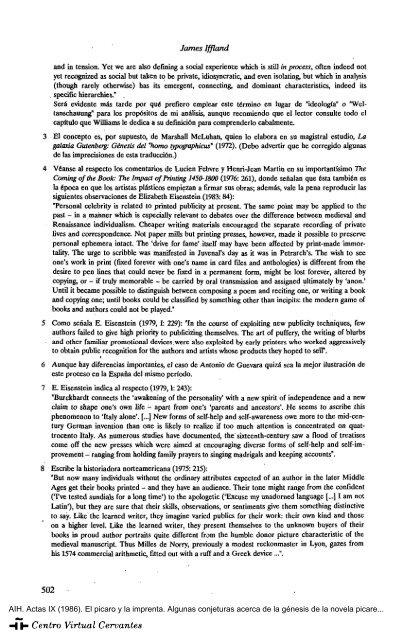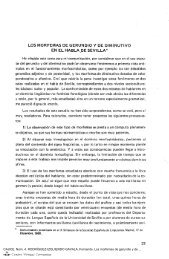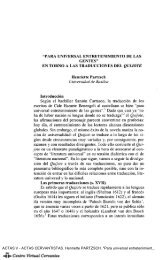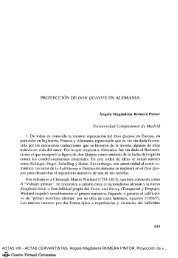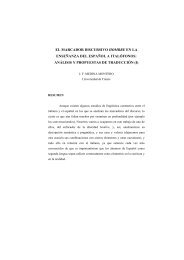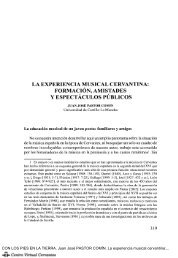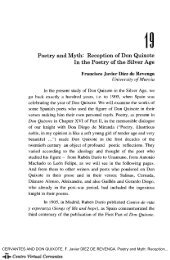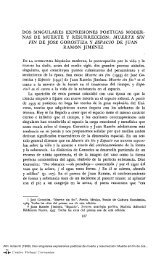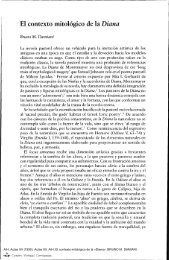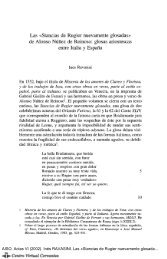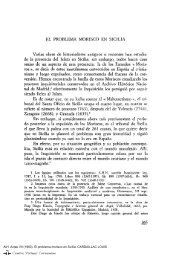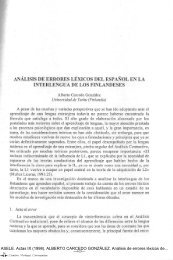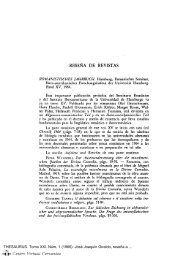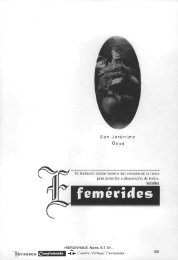El picaro y la imprenta. Algunas conjeturas acerca - Centro Virtual ...
El picaro y la imprenta. Algunas conjeturas acerca - Centro Virtual ...
El picaro y la imprenta. Algunas conjeturas acerca - Centro Virtual ...
Create successful ePaper yourself
Turn your PDF publications into a flip-book with our unique Google optimized e-Paper software.
James Iff<strong>la</strong>nd<br />
and in tensión. Yet we are also defining a social expeliente which is still in process, often indeed not<br />
yet recognized as social but taken to be prívate, idiosyncratic, and even iso<strong>la</strong>ting, but which in analysis<br />
(though rarely otherwise) has its emergent, connecting, and dominant characteristics, indeed its<br />
. specific hierarchies." ,<br />
Será evidente más tarde por qué prefiero emplear este término en lugar de "ideología" o "Weltanschauung"<br />
para los propósitos de mi análisis, aunque recomiendo que el lector consulte todo el<br />
capítulo que Williams le dedica a su definición para comprenderlo cabalmente.<br />
3 <strong>El</strong> concepto es, por supuesto, de Marshall McLuhan, quien lo e<strong>la</strong>bora en su magistral estudio, La<br />
ga<strong>la</strong>xia Gutenberg: Génesis del "homo typographicus" (1972). (Debo advertir que he corregido algunas<br />
de <strong>la</strong>s imprecisiones de esta traducción.)<br />
4 Véanse al respecto los comentarios de Luden Febvre y Henri-Jean Martin en su importantísimo The<br />
Corning ofthe Book: The Impact ofPrinting 1450-1800 (1976: 261), donde seña<strong>la</strong>n que ésta también es<br />
<strong>la</strong> época en que los artistas plásticos empiezan a firmar sus obras; además, vale <strong>la</strong> pena reproducir <strong>la</strong>s<br />
siguientes observaciones de <strong>El</strong>izabeth Eisenstein (1983:84):<br />
"Personal celebrity is re<strong>la</strong>ted to printed pubücity at present. The same point may be applied to the<br />
past - in a mahner which is especially relevant to debates over the difference between medieval and<br />
Renaissance individualism. Cheaper writing materials encouraged the sepárate recording of private<br />
Uves and correspondence. Not paper milis but printing presses, however, made it possible to preserve<br />
personal ephemera intact. The 'drive for fame' itself may have been affected by print-made immortality.<br />
The urge to scribble was manifested in Juvenal's day as it was in Petrarch's. The wish to see<br />
one's work in print (fixed forever with one's ñame in card files and anthologies) is different from the<br />
desire to pen lines that could never be fixed in a permanent form, might be lost forevér, altered by<br />
copying, or - if truly memorable - be carried by oral transmission and assigned ultimately by 'anón.'<br />
Until it became possible to distinguish between composing a poem and reciting one, or writing a book<br />
and copying one; until books could be c<strong>la</strong>ssified by something other than incipits: the modern game of<br />
books and authors could not be p<strong>la</strong>yed."<br />
5 Como seña<strong>la</strong> E. Eisenstein (1979, I: 229): "In the course of exploiting new publicity techniques, few<br />
authors failed to give high priority to pubh'cizmg themselves. The art of puffery, the writing of blurbs<br />
and other familiar promotional devíces.were also exploited by early printers who worked aggressively<br />
to obtain public recognition for the authors and artists whose products they hoped to sell".<br />
6 Aunque hay diferencias importantes, el caso de Antonio de Guevara quizá sea <strong>la</strong> mejor ilustración de<br />
este proceso en <strong>la</strong> España del mismo período.<br />
7 E. Eisenstein indica al respecto (1979,1:243):<br />
"Burckbardt connects the 'awakening of the personality" with a new spirit of independence and a new<br />
c<strong>la</strong>im to shape one's own Ufe - apart from one's 'parents and ancestors'. He seems to ascribe this<br />
phenomenon to 'Italy alone'. [...] New forms of self-help and self-awareness owe more to the mid-century<br />
Germán invention than one is likely to realize if too much attention is concentrated on quattrocento<br />
Italy. As numerous studies have documented, the sixteenth-century saw a flood of treatises<br />
come off the new presses which were aimed at encouraging diverse forms of self-help and self-improvement<br />
- ranging from holding family prayers to singing madrigals and keeping accounts".<br />
8 Escribe <strong>la</strong> historiadora norteamericana (1975: 215):<br />
"But now many individuáis without the ordinary attributes expected of an author in the <strong>la</strong>ter Middle<br />
Ages get their books printed - and they have an audience. Their tone might range from the confident<br />
(Tve tested sundials for a long time') to the apologetic ('Excuse my unadorned <strong>la</strong>nguage [...] I am not<br />
Latin'), but they are sure that their skills, observations, or sentiments give them something distinctive<br />
to say. Like the learned writer, they imagine varied publics for theír work: their own kind and those<br />
on a higher level. Like the learned writer, they present themselves to the unknown buyers of their<br />
books in proud author portraits quite different from the humble donor picture characteristic of the<br />
medieval manuscript. Thus Milles de Norry, previously a modest reckonmaster in Lyon, gazes from<br />
his 1574 commercial arithmetic, fitted out with a ruff and a Greek device ...".<br />
502


